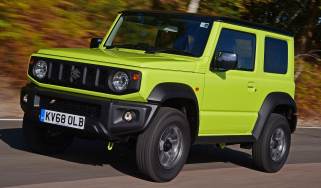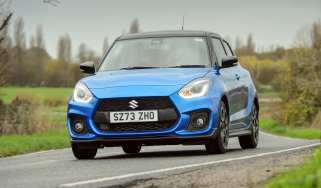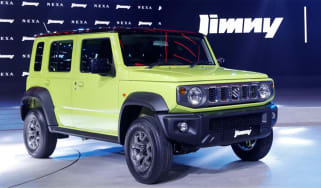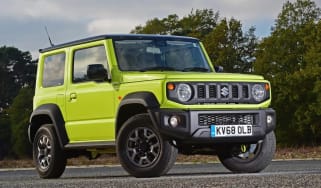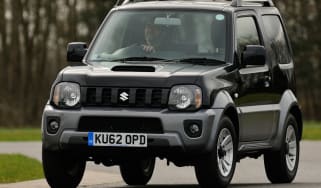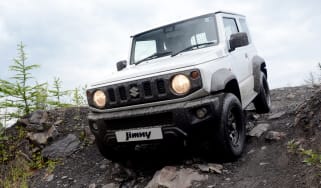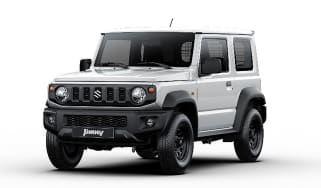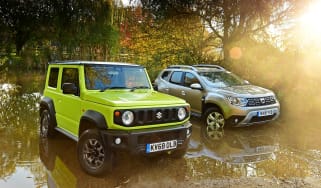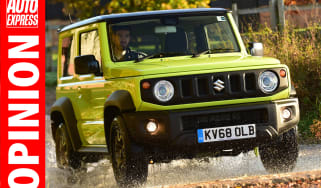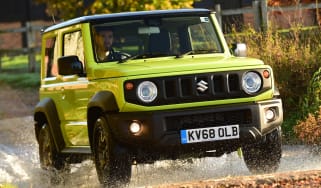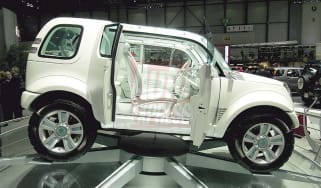Suzuki Jimny (2018-2020) review
Comprehensive changes bring the Suzuki Jimny into the 21st Century. It isn’t perfect, but it’s full to the brim with quirky charm

The Suzuki Jimny remains a niche player in a market dominated by refined and capable crossovers. If you want a fine-handling SUV, this is not the car for you. However, if you’re after an unstoppable small 4x4 with impressive off-road ability, little else comes close. It offers loads of retro charm inside and out, with sharp styling and a durable interior. Limited availability due to high demand means you may have to wait if you want to order one, however.
Despite never selling in huge numbers, there’s an enduring appeal to the Suzuki Jimny that’s matched by few other small SUVs. Whether that comes down to its super-cool retro styling or its unflappable off-road ability is for you to decide – but as market tastes change and people demand more from their cars, does the mini 4x4 still have what it takes?
In a world dominated by pseudo-SUVs and road-biased crossovers, the tough old Jimny stuck out like a sore thumb. But the fourth-generation car is said to be the most technologically advanced Jimny ever – with class-leading off-road ability and vastly improved on-road dynamics.
There’s just one bodystyle to choose from, and while prices haven’t been announced, we do know there will be two trims available at launch. The 100bhp 1.5-litre petrol engine does without a turbo but gets a choice of manual and automatic transmissions. All cars come with ALLGRIP Pro all-wheel drive and a rudimentary ladder-frame chassis.
Used - available now

2022 Peugeot
208
39,907 milesManualPetrol1.2L
Cash £13,100
2022 Peugeot
208
53,124 milesManualPetrol1.2L
Cash £10,400
2022 Volvo
XC40
15,804 milesAutomaticPetrol2.0L
Cash £25,925
2022 DS
DS 3 CROSSBACK E-TENSE
20,519 milesAutomaticElectric
Cash £11,897Entry-level SZ4 cars come with air-conditioning, cruise control, DAB radio and Bluetooth, but miss out on the SZ5’s touchscreen infotainment system. The more lavishly equipped cars gain rear privacy glass, climate control, heated seats and sat-nav. Our pick of the range will depend heavily on pricing, but the SZ5 appears to add a number of items many buyers will see as essentials in this part of the market.
Suzuki Jimny alternatives
It’s hard to pin down direct rivals for the new Suzuki Jimny. While it’s clear the designers have taken inspiration from cars like the Land Rover Defender, Mercedes G-Class and Jeep Wrangler, in reality, it’s pitched alongside more road-biased crossovers like the Renault Captur, Hyundai Kona and Nissan Juke. Arguably its closest competitor is the no-frills Dacia Duster SUV – but that car can’t come close to the Jimny’s retro appeal and desirability.
Within the Suzuki range, the Jimny sits above the jacked-up Ignis supermini, and below the S-Cross and Vitara SUVs. As previously mentioned, however, its off-road ability is unrivalled at this price – both within the Suzuki line-up and elsewhere in the new car market.
Engines, performance and drive
Built to cope with some of the most challenging off-road routes, deepest streams and highest mountains, the new Suzuki Jimny simply can’t match the best crossovers for on-road handling.
All versions come with ALLGRIP Pro all-wheel drive as standard, with three settings: 2H, 4H and 4L. In normal driving, the Jimny is driven via the rear wheels only but, in case you wondering, this is no sports car. While it feels much more secure than the old Jimny, it still rolls through the corners, shimmying over rough tarmac and potholes.
Out on the motorway, the Jimny’s struggles are even more apparent. The standard-fit five-speed manual box and short gearing mean the engine is quite noisy at 70mph, while the limited power ensures you’ll need to plan your overtakes more carefully than you might in one of the Suzuki’s turbocharged rivals. Still, road noise and wind noise are well suppressed, so keep things below 50mph and it’s a relatively refined place to be. It’s difficult at this stage to comment on ride comfort, as our road route across Germany was confined to smooth, ripple-free tarmac.
Given its small size, you’d expect the Suzuki Jimny to be well suited to town driving. However, the steering is slow and vague, which makes parking and low-speed manoeuvres quite tricky; if you don’t wind the lock off quickly, you’ll find yourself on the wrong side of the road.
Where the Suzuki Jimny really shows its worth, is off-road. We completed a relatively challenging course in a private forest in Germany and were blown away by how easy it was to drive. There’s loads of ground clearance and plenty of grip, while the low range gearbox setting, hill hold and hill descent control systems make light work of rougher ground and steeper slopes. Yes, the soft suspension throws you around, but there’s very little that can stop the terrifyingly tough Jimny out in the wild.
Engines, 0-60 acceleration and top speed
The Suzuki Jimny is offered with just one engine option – and things are likely to stay that way for some time. The sole 1.5-litre naturally aspirated petrol produces 100bhp and 130Nm of torque; a top speed of 90mph is achievable but there's no official 0-62mph time at present – somewhere in the region of 13 seconds is realistic.
Due to the car’s low kerbweight, it feels sprightly enough. There are two gearbox options: a five-speed manual and a four-speed auto. We’ve only tried the manual model for the time being, and while it is responsive enough in the lower gears, the short fifth cog means it is noisy at motorway speeds. A sixth gear would improve things in this regard.
MPG, CO2 and running costs
Don’t be fooled: despite the new Suzuki Jimny’s lightweight construction and dinky dimensions, it’s unlikely to be a cheap car to run. Especially if you often drive off-road in 4x4 mode.
Official fuel consumption ranges from 32.1 to 35.8mpg on average depending on spec – with those cars on bigger wheels likely to be slightly less efficient. CO2 emissions start at 154g/km and rise to 170g/km on some models. There is no super-frugal diesel model.
For comparison, a Dacia Duster (in petrol guise) will emit between 145g/km and 158g/km, while diesel versions reduce this to as little as 115g/km. The most efficient front-wheel-drive versions can return as much as 64.2mpg.
Insurance groups
SZ4 models sit in insurance group 13, while top-spec SZ5 cars occupy group 15. For comparison’s sake, the Dacia Duster sits between group 8 and group 12.
Depreciation
Despite launching way back in 1998, even now the old Jimny will retain up to 53 per cent of its value after three years or 36,000 miles, with the latest model holding on to around 55 to 56 per cent over the same period, according to our experts. A Dacia Duster is similarly competitive, but crossover rivals like the Renault Captur and Nissan Juke fall some way short.
To get an accurate valuation on a specific model check out our free car valuation tool...
Interior, design and technology
The latest Suzuki Jimny is a rugged 4x4 that has been redesigned for the 21st Century. It’d be fair to say there are hints of Land Rover Defender, Jeep Wrangler and Mercedes G-Class in the design, but despite its rudimentary ladder-frame chassis, it’s better to drive and more comfortable than before.
Inside, the exterior’s square theme continues, with plenty of straight lines and harsh edges. Quality is on par with rivals like the Dacia Duster, with scratchy plastics on the dash and doors; the Jimny is built to stand the test of time rather than feel particularly luxurious.
This being a Suzuki, most of the kit you’d want comes as standard on SZ5 cars. However, the firm is hoping to offer a selection of customisation options – including styling tweaks, roof racks and different front grilles. There are lots of vibrant colours to choose from, too, including Kinetic Yellow, Brisk Blue and Chiffon Ivory.
Sat-nav, stereo and infotainment
Only top-spec Suzuki Jimny SZ5 models benefit from a touchscreen as standard. Basic SZ4 cars get a CD player, Bluetooth connectivity and DAB radio, but make do with a simple screen and manual air-conditioning.
Here, we’ll focus on the SZ5’s infotainment set-up. It’s a system we are familiar with from various other Suzuki models such as the Swift, S-Cross and Vitara. It’s not the most responsive unit, but there’s loads of functionality – including sat-nav, Apple CarPlay and Android Auto. The main menu consists of four easily distinguished shortcut squares, which allow easy access to things like the radio and phone settings.
Unsurprisingly, there are no digital dials or fancy night vision settings, but the dash is easy to navigate and intuitive to use. There’s a small screen in between the speedo and rev counter – providing trip information like fuel economy and predicted range.
Practicality, comfort and boot space
The Suzuki Jimny’s tiny footprint means it isn’t the most practical car. There’s enough room inside for four passengers to sit relatively comfortably – albeit without any luggage whatsoever. The boot is positively minuscule, in fact - even with the seats lowered. Still, if your idea of practicality is a small SUV that can go almost anywhere, the Jimny could be the car for you.
Dimensions and size
At less than 3.5m-long, the latest Suzuki Jimny is shorter than all its main rivals. It’s 30mm shorter than the car it replaces, in fact, making it easy to park and manoeuvre; or at least, it would be if the steering wasn’t so slow to react.
Sitting 20mm taller and 45mm wider makes it bigger inside, but doesn’t drastically change the way the car feels on the road. The short front and rear overhangs help make it one of the most capable cars on sale when it comes to off-roading, too.
Legroom, headroom & passenger space
Despite its dinky dimensions, the Suzuki Jimny is surprisingly accommodating for front and rear passengers. There’s enough room for taller adults up front – although a lack of reach adjustment on the steering wheel can make for a slightly awkward driving position.
Clambering into the back is no mean feat, but once you’re there you’ll find adequate head and knee room for a six-foot adult. The seats recline for extra comfort, but those with longer legs may find the floor a little high.
There are only two seats in the back, but both feature ISOFIX child seat mounts. Each of the rear seats is easily raised and/or folded from the boot, too.
Boot space
By providing adequate rear-seat space, Suzuki has sacrificed the Jimny’s boot to a great extent. With just 85 litres on offer with the rear seats in place, there’s more luggage space in a Mazda MX-5. You’ll find enough room for a laptop bag or soft rucksack, but carrying anything more requires you to fold the two back seats. You can’t even blame a bulky spare wheel, as that’s fitted to the back door like before.
Handily, the back seats split 50:50 and fold down to reveal a completely flat 377-litre load bay; almost as much as you get in a Volkswagen Golf with the rear seats in place. The Jimny is hardly the most practical car for carrying cumbersome kit, then.
That said, Suzuki will offer an optional fold-flat passenger seat, which should help when carrying longer items. Roof racks are available, and Suzuki even thought to reposition the aerial, to allow easy transportation of surfboards or top boxes.
Towing
Despite its rugged looks and capable 4x4 system, the tiny Suzuki Jimny is only capable of towing a 1,300kg braked trailer. Fix an unbraked load to the back of the car and you’re limited to just 350kg.
Being a back-to-basics no-frills SUV, there are no fancy tow assist features.
Reliability and safety
It’s tricky to comment on reliability given the Suzuki Jimny is so new. However, the company finished 8th overall out of 30 manufacturers in our 2019 Driver Power owner satisfaction survey, suggesting most customers are happy with the service of their supplying dealer and the reliability of their cars.
Certainly, on our test drive, the new Jimny felt solidly built and designed to withstand truly tough off-roading. As a result, we’ve no reason to believe the little 4x4 will be anything other than bulletproof should you choose to buy one.
With regards to safety, Euro NCAP recently announced a disappointing three-star verdict for the Jimny. Although it performed admirably in the Adult (73 per cent) and Child (84 per cent) Occupant protection categories, it scored poorly for Safety Assist (50 per cent) and Pedestrian Protection (52 per cent). The Dacia Duster was also granted three stars, however, with poorer scores in all but the Pedestrian protection category.
The latest Jimny is loaded with more kit than ever, however, including Dual Sensor Brake Support (DSBS), Lane Departure Warning and traffic sign recognition. There are six airbags, too.
Warranty
Every new Suzuki, including the Jimny, comes with a three-year, 60,000-mile warranty. It’s competitive but far from class leading; Toyota offers a free five-year guarantee on all of its cars, for example. Still, it’s easy and fairly cost-effective to extend the standard Suzuki warranty with a choice of ‘Basic’, ‘Select’ and ‘Comprehensive’ cover options.
Servicing
The Suzuki Jimny is available with the same service payment plans on offer across the rest of the range. The company’s dealer packages fix the prices for parts and labour for up to three years, using only Suzuki-trained technicians and certified spare parts.



